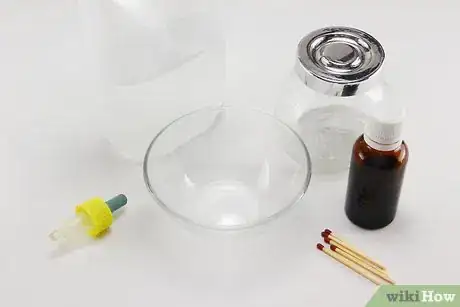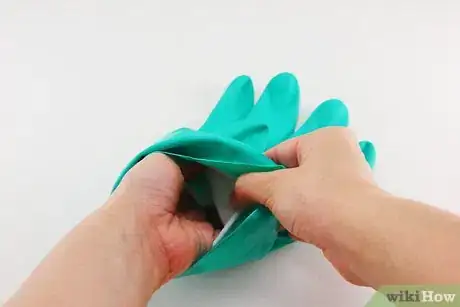This article was co-authored by Bess Ruff, MA. Bess Ruff is a Geography PhD student at Florida State University. She received her MA in Environmental Science and Management from the University of California, Santa Barbara in 2016. She has conducted survey work for marine spatial planning projects in the Caribbean and provided research support as a graduate fellow for the Sustainable Fisheries Group.
This article has been viewed 73,872 times.
Acid rain is the result of the pH of water in the sky dropping below 5.6.[1] This happens because of gases that are emitted into the environment and then trapped in the water, lowering the pH. You can simulate acid rain using various methods, but 2 experiments in particular allow you to simulate it easily, inexpensively, and quickly. In one, you can help children see how gases in the air combine with water to create an acid. In the other, you can show how acid rain affects the growth of plants and the environment. Both experiments help illustrate the effects of car emissions and acid rain on the environment.
Steps
Demonstrating Emissions-Based Acid Production
-
1Gather the necessary materials. This experiment simulates the emission of harmful gases into the environment that combine with water in the sky to lower the pH and cause acid rain. To perform this simulation, you will need an eyedropper, distilled water, a glass jar with a lid, bromothymol blue, a small clear container, and sulfur-based matches.
- Choose safety matches, which contain more sulfur and less phosphorus than other types.[2] Adult supervision is recommended while using the matches.
- Bromothymol blue is a solution that changes color when pH drops and can be purchased online.
- The small container can be glass or plastic as long as it is clear.
-
2Prepare the bromothymol blue solution. Pour about 10 mL of distilled water into the small clear container. The exact amount of water doesn’t matter, but 10 mL is a good amount for this experiment. Use the eyedropper to gradually add the bromothymol blue to the distilled water until the solutions turns a light blue.
- 10 mL is about equal to 2 teaspoons.[3]
- When bromothymol blue comes into contact with an acid, the color of the solution turns yellow.
Advertisement -
3Collect “emissions” by burning matches in a jar. Light several matches and then drop them in a glass jar while still lit. Place the lid on to collect the gases. Wait until the matches burn out.
- With the lid on the jar you have trapped the carbon dioxide and sulfur gases produced by the matches. These gases are the same gases that get trapped in our atmosphere due to vehicle emissions.
- Have adult supervision during this step.
-
4Add the bromothymol blue solution to the jar. Open the jar containing the matches and pour the entire container of bromothymol blue solution into the jar. Put the lid back on the jar as quickly as possible to keep all of the gases in the jar.
- Shake the jar to mix the gases from the matches with the bromothymol blue solution.
-
5Observe what happens to the color of the liquid in the jar. Because bromothymol blue turns yellow when acid is introduced to it, you should observe that the solution has turned yellow. This experiment is a model of how gases can dissolve in water to decrease the pH of the water, making it more acidic, just like how vehicle emissions get trapped in the atmosphere and create acid rain.
- If the water doesn’t turn yellow, you may need to burn more matches to trap more gas.
- Alternatively, you can use less water and try again.
Simulating the Environmental Effects of Acid Rain
-
1Gather the necessary materials. This experiment simulates how acid rain affects the environment and plants.[4] To do it, you will need 2 small potted plants, sulfuric acid, distilled water, an eyedropper, a pH meter or pH strips, and a spray bottle.
- If you want to do this easily at home, you can use vinegar or lemon juice instead of sulfuric acid. You don’t need an eyedropper or pH meter if you use vinegar or lemon juice.
-
2Work in a safe environment. When working with strong acids like sulfuric acid, you need to wear a lab coat, lab safety gloves, and safety goggles. Always wear this protective equipment when handling the sulfuric acid. Adult supervision is required for this process.
- Do not lean over or breathe in the acid.
-
3Add sulfuric acid to the distilled water. Fill a small container with distilled water. The exact amount isn’t important, but one cup of water should be sufficient. Using the eyedropper, add some sulfuric acid to the water, stir, and check the pH with the pH meter. Keep adding sulfuric acid and stirring until the water has a pH around 4.0.
- If you’re using pH strips, dip the strip into the water and wait until the strip changes color. Compare that color to the key to determine what the pH of your solution is. Keep checking the pH with a new strip each time until you get to 4.0.
- If you’re using vinegar/lemon juice, skip this step.
-
4Spray the potted plant with the sulfuric acid solution. Add your acidic water (or vinegar/lemon juice) solution to a spray bottle and spray 1 of the plants with the “acid rain.” Spray the second plant with plain distilled water. Repeat this process once a day for a week and observe the results.
- Monitor the state of your plants over time, noting the effects on the plants.
- After a few days, you should notice that the plant sprayed with the acid rain develops brown/yellow leaves and is badly damaged compared to the plant with just distilled water. This shows the effect of acid rain on the environment.
Community Q&A
-
QuestionWhy is vinegar used in the simulation?
 Community AnswerBecause this is one the safest methods of simulating acid rain with a fixed pH level.
Community AnswerBecause this is one the safest methods of simulating acid rain with a fixed pH level. -
QuestionIf you don't add bromothymol blue, but followed the same steps in Method 1, would the created product mimic acidic rain?
 HanCommunity AnswerYes. The purpose of bromothymol blue is to indicate the acidity and verify that you have actually created acidic rain. If you don't add bromothymol blue, but follow all the other steps correctly, you should still end up with an acidic solution. You just won't be able to verify it.
HanCommunity AnswerYes. The purpose of bromothymol blue is to indicate the acidity and verify that you have actually created acidic rain. If you don't add bromothymol blue, but follow all the other steps correctly, you should still end up with an acidic solution. You just won't be able to verify it.
Warnings
- Wear the appropriate safety gear – sealing goggles, chemical gloves with cuffs, a face shield, leather shoes and a chemical apron – when handling acids, and work with them only in well-ventilated environments.⧼thumbs_response⧽
- Never work with acids when alone.⧼thumbs_response⧽



































































